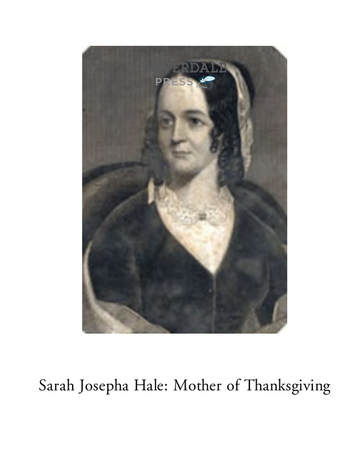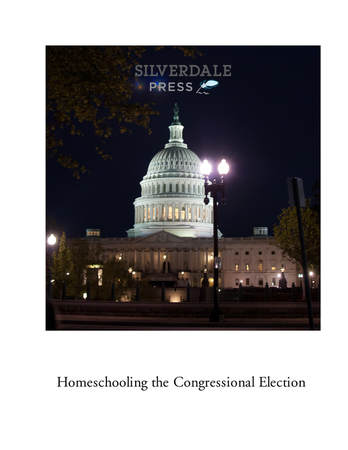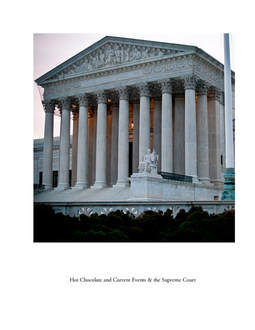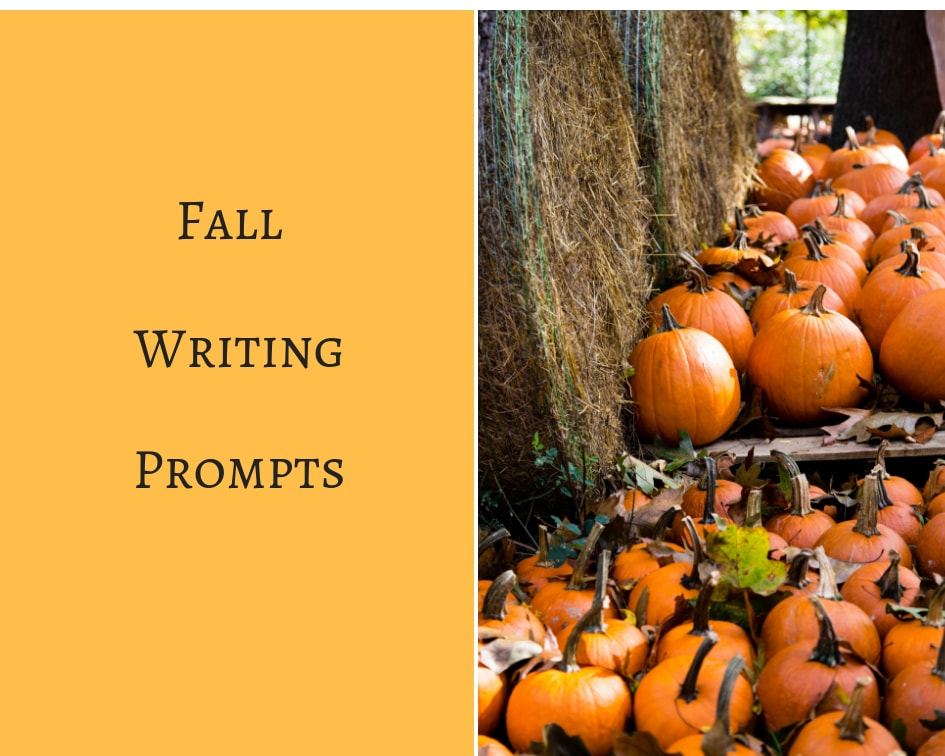 Do you know the story of the mother of Thanksgiving? Sarah Josepha Hale is one of the most fascinating women in American history. If you don’t know her, our homeschool Thanksgiving Unit Study tells the story of how she wrote to--and eventually persuaded--U.S. presidents to declare national days of Thanksgiving. Here’s a bit about Sarah. Sarah was born in Newport, New Hampshire on October 24, 1788, the year before George Washington became the first president of the United States. Schools and colleges did not educate girls back then. This irritated Sarah, but her mother gave her a good education at home. As a girl, she read the Bible and John Bunyan’s Pilgrim’s Progress. Her brother taught her Latin, math, and philosophy. As she grew older, she championed early education for children. She even opened a preschool, called a dame school, and taught her pupils the alphabet, numbers, and even beginning Latin. She read her brother’s college textbooks (he went to Dartmouth), vicariously receiving a college education through him. When Sarah was 22, her father, a Revolutionary War veteran, sold their farm and opened a tavern. It was there Sarah met a young lawyer named David Hale. Several years later, on October 23, 1813, Sarah and David Hale were married. Back then, married women did not have careers, but Sarah and David devoted two hours each day to reading and writing. Sarah loved those hours. David recommended books, and the couple discussed them together. David thought his wife was an excellent writer, and he sent the poems she wrote to newspapers in hopes that they would publish them. Sarah and some friends even started a writers’ group called the Newport Coterie. Between 1815 and 1820, Sarah gave birth to four children: David, Horatio, Frances Ann, and Sarah Josepha. Then in 1822, tragedy struck. Sarah was pregnant with her fifth child, William, when her husband died of pneumonia. She was only thirty-four years old. Though David’s law practice was successful, he was young and had not saved much money. Sarah would have to raise five children and provide for her family on her own. Fortunately, David’s friends were looking out for Sarah. They knew about her writing talents, and they helped her to publish a collection of poems: The Genius of Oblivion and Other Original Poems. She also wrote newspaper and magazine articles and completed a book called Northwood. The book compared life in the North to the slave-owning South after the Revolutionary War. In it, she described a traditional New England Thanksgiving. Sarah’s book was such a success that Reverend John Blake asked her to be the editor of a new women’s magazine he was publishing called Ladies Magazine. Reverend Blake wanted to use the magazine to set a model for American womanhood. Since Sarah needed money to support her family, she accepted the offer. As “editress,” as she was known, of Ladies Magazine, Sarah had to write persuasively. Her first challenge was to get husbands to agree to pay three dollars for the annual subscription fee. This was a heavy sum at the time. She had to convince them that Ladies Magazine would benefit them. Sarah claimed that if women had more knowledge, they would be better mothers. Better mothers meant better children, which could only lead to a better country. Sarah’s argument worked. Subscriptions rolled in, and the magazine was a success. Sarah’s work as an “editress” kept her busy. She had to write her own editorials, poems, book reviews, and articles, as well as revise and edit the work of other writers for the magazine. While she was busy editing, she even wrote a small book of poems called Poems for Our Children. It contained the poem “Mary’s Lamb,” known today as “Mary Had a Little Lamb.” In 1836, Ladies Magazine merged with Godey’s Lady’s Book, owned by Louis Godey. While Louis Godey did not allow Sarah to take political sides in her writing, he did allow her to write about issues she felt were important. Today, Sarah is best known as the mother of Thanksgiving. From the late 1840s through the 1870s, Sarah argued in Godey’s Lady’s Book that America should celebrate a national day of Thanksgiving on the last Thursday in November. Sarah grew up celebrating Thanksgiving in New England, and she hoped people around the country, in the North and South, could use the holiday to celebrate their common heritage. Sarah wrote to U.S. presidents to try to persuade them to declare national days of Thanksgiving. In the midst of the bloody Civil War, she twice persuaded Abraham Lincoln to declare national days of Thanksgiving. Sarah was almost ninety years old when she finally gave up her editing job. She died at age ninety-one in the year 1879. Sarah's story is just one slice of Thanksgiving history. To learn more, check out our homeschool Thanksgiving Unit Study.
0 Comments
 Need a break from your regular curriculum? Veterans Day is coming up. We at Silverdale Press can help you seize the holiday as a unique, enriching learning experience. For a limited time, get our Veterans Day Unit Study for FREE! Do you know what’s so special about Veterans Day 2018? Before Veterans Day was Veterans Day, it was actually called Armistice Day. One hundred years ago this Veterans Day, we signed the armistice that ended World War I. Don’t know the history behind our national holiday? Here’s your chance to learn all about it and make meaningful memories with your family at the same time. Download our White House Holidays: Veterans Day Unit Study for FREE. It’s our gift to you in celebration of the 100th anniversary of the holiday that grew into Veterans Day. Use the coupon code VETFREE at checkout. The coupon is only good until November 1, so order now. With beautiful illustrations, meaningful activities, and rich history, your family will learn about the following topics:
Best of all, we provide everything you need. Our unit studies are so easy for parents to use! And if you haven’t already, download our free Veteran Oral History Guide to use as a supplement. If you have a family member or friend who is a veteran, this is a great way to record their stories for posterity. We hope this free unit study blesses your family, as you teach your kids about our national history.  At Silverdale Press, we love to help your family learn about elections. For the next several weeks, our Hot Chocolate and Current Events will focus on the upcoming congressional election in the U.S. Studying current events has so many benefits. Not only does it increase vocabulary, it can help you pass along values to your children. Since everyone is talking about the congressional election, now is a great time to have a purposeful discussion with your kids about it. But first, some information: -This is a midterm election year, meaning that it happens in between presidential elections. -All 435 members of the U.S. House of Representatives are up for reelection. -Out of 100 Senate seats, 33 seats are being contested in regular elections and 2 are being contested in special elections. -Those elected to the House will serve two-year terms; those elected to the Senate will serve 6-year terms. -Republicans currently hold majorities in both houses. -Voter turnout for midterm elections is around 40 percent. Hop on over to our blog to get the article, map points, and discussion questions. Get the article: https://www.usatoday.com/story/news/politics/elections/2018/10/17/donald-trump-midterm-themes-kavanaugh-impeachment-nicknames/1590500002/ Plot these points on a map: Washington, D.C.; Montana; Arizona; Nevada Discuss the following questions: What is the main topic of this article? Why is Donald Trump campaigning so hard in the congressional election? If Democrats get control of Congress, do you think they’ll try to impeach the president or the new Supreme Court justice, Brett Kavanaugh? What message do you think the president needs to get across at his rallies, in order to get Republicans to turn out and vote? Why is voter turnout so low in congressional midterm elections? Do you think voter turnout will be higher this year than its usual 40 percent? Do you think this election is a referendum on the president’s leadership? Why do you think President Trump is holding more rallies than Presidents Bush and Obama did? Why do you think the president is looking forward to the next three weeks?  The Supreme Court: What’s Ahead on the Docket The Supreme Court convened for its new term on the first Monday in October, as it does every year. With new associate justice Brett Kavanaugh recently confirmed and sworn in, we take a look at what’s ahead on the Court’s docket. Quick fact: The Supreme Court only hears about 70 to 80 cases per year, and the vast majority of those cases are not headline-grabbing civil rights and liberties issues. 1. Get the article from Voice of America https://www.voanews.com/a/us-supreme-court-new-term/4592566.html 2. Note the following vocabulary words: Docket: a calendar or list of cases for trial Cert: Refers to a petition for a writ of certiorari, or the petition through which parties ask the Supreme Court to take a case Stare decisis: a legal principle that is translated “let the decision to stand” and binds justices to uphold cases on the basis of precedent Precedent: previously decided cases 3. Plot the following point on a map: Washington, D.C. 4. Answer the following questions:-What is the main issue raised in this article? -When do you think the Supreme Court should revisit and even overturn past decisions? -Why do you think the three cases highlighted are worthy of a hearing by the Supreme Court? Are they issues that average people care about? -Do you think the Court should accept and decide politically divisive cases?  Greetings! Teaching homeschool writing is hard. But do you know the secret to your child improving his or her writing skills? It’s regular writing practice. Writers write. It’s as simple as that. Engaging prompts also help your child to enjoy the writing process. That’s why we at Silverdale Press have created these 10 fall writing prompts. These prompts span the categories of writing: persuasive, expository, informative, creative, and narrative. Lost in a corn maze (story starter/narrative fall writing prompt): You and a friend are running through an empty corn maze on a cool, autumn night. Your flashlight suddenly burns out. You look down to see what is the matter. When you turn around, your friend is gone. Write a story about what happens next. Be sure to use lots of action words. Pen pal letter (explanatory/descriptive fall writing prompt): Write a letter to a pretend pen pal in a foreign country. Describe how your town celebrates fall. Be sure to include local food, festivals, and activities. Autumn poem (fall creative writing prompt): Take an autumn nature walk. Bring along a notebook and pencil. Write a poem about the natural splendor of autumn. Football: yes or no? (fall persuasive writing prompt): If football is dangerous, should parents let their kids play the sport? OR If football is dangerous, should we watch it on television? Apples: which kind is best? (fall persuasive writing prompt): Complete this statement. ____________ is the best kind of apple because ___________________. Pumpkin patch story starter (fall creative writing prompt): Finish the following story. I was walking along in the pumpkin patch, when a black crow landed on my shoulder… October 31 (explanatory fall writing prompt): Some families celebrate Halloween, while others do not. Write a short essay explaining how and why your family does or does not celebrate Halloween. Veterans Day (persuasive fall writing prompt): Veterans Day is November 11. What does our country owe to those who served in the military? Thanksgiving turkey (creative fall writing prompt): Write silly instructions on how to cook a Thanksgiving turkey. Thanksgiving menu (descriptive fall writing prompt): You are in charge of writing a Thanksgiving menu (real or imaginary) for your family’s Thanksgiving feast. List the dishes as on a real menu. List the name of each dish, as well as a one-line description underneath. Be sure to use sensory language, describing taste, smells, textures. |
Silverdale PressCheck out our About Page to learn more about us! Categories |

 RSS Feed
RSS Feed